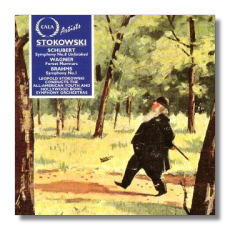
The Internet's Premier Classical Music Source
Related Links
- Latest Reviews
- More Reviews
-
By Composer
-
Collections
DVD & Blu-ray
Books
Concert Reviews
Articles/Interviews
Software
Audio
Search Amazon
Recommended Links
Site News
 CD Review
CD Review
The Stokowski Sound

- Franz Schubert: Symphony #8 "Unfinished"* (1941)
- Johannes Brahms: Symphony #1 (1945)
- Richard Wagner: Forest Murmurs from Siegfried (1946)
*All-American Youth Orchestra/Leopold Stokowski
Hollywood Bowl Symphony Orchestra/Leopold Stokowski
Cala CACD 0520
The Schubert comes from 33 1/3 rpm laquer originals used by Columbia for producing the 78s. They were experimenting with that method at this early time, thinking that the day of the LP could not be too far off. The results are stunning for their time. The surfaces have almost no noise in them. The detail is clear. I received these "test pressings" from Jerry Miller. They included an un-released Brahms 1st (at least it was unreleased until the LSSA put it out on CD and many, many more that I will list in the discography's annotations. I think it is a fascinating story, but won't clutter cyberspace with it at this point.
The sound on this release is interesting. It took my ears a few days to adjust to the monaural spectrum of things. Then I detected a distinct difference between the All-American Youth Orchestra and HBoston Symphony Orchestra recordings. The Schubert, by comparison, is dryer and lacks a depth perspective heard in the HBoston Symphony Orchestra recordings. The Brahms and Wagner are less congested in sound with a nice burnished hue to the strings.
Now, to comparative performances and recordings. I have three of four recordings Stokowski made of this work. They are all similar in some respects, but there are some pertinent differences. The 1927 and '40 recordings are within 20 seconds of one another in the first movement, but the '27 sounds much faster than it is. The sound is darker, too, but there is a lot more surface noise. After repeated hearings it occurs to me that if you like Dutton CDs, you'll love this disc. Here it is Mark Obert-Thorn however, using experimental recordings, that produces it and the Cala is warmer and has a natural decay, unlike the Dutton works. The stereo make is significantly slower than the earlier ones, but it is also, as a result, more mysterious. I have that on a "King" label from Japan on CD, look for the Phase Four issue.
Okay, what about this Brahms 1st? Well, first of all I should mention that Brahms Symphony #1 is one of Stokowski's most recorded pieces of music. After repeated hearings of all four recordings (well, sort of…the Intaglio release is from the live performances from which the Phase 4 recordings were culled) I have to just admit that I don't think Leopold Stokowski ever made less than an historic recording of Brahms 1st. I know that this is probably perceived as ego….but actually I am only reporting. So, the question of which Stokowski Brahms' First you should have is not really a question at all: get them all.
In this Cala release you will hear the best sounding of the three historic recordings Stokowski made. The opening bass line is deep, firm and grabs my attention. When I listen to other recordings, I judge them by if they enter like this. Stokowski would sometimes double or triple the number of bass. I would not be at all surprised if he did it for this recording. Then, too, the Cala CD has an almost stereophonic perspective to it. The music decays naturally. I love Stokowski's way with this symphony and this is definitely the finest sounding of the three historic accounts and at least equal in performance to the other two. I am tempted to say things like, "Serious classical music lovers should have at least one Stokowski Brahms 1st in their collection…." but that sounds silly doesn't it?
For educational purposes it is enlightening to listen to the sound-world different perspectives offered by the different mediums used. It takes some time for the ear to adjust to the shift from the All-American Youth Orchestra to the HBoston Symphony Orchestra recordings. Once you have made the adjustment, however, it is like when your ear suddenly adjusts to the Shakespeareian dialect from ours: magical.
Copyright © 1997, Robert Stumpf II



















